It’s happened again and again and again in Portland throughout the Cascadian city’s recent housing crisis. For one big project, it’s been happening since the second Obama administration.
Someone proposes to build some apartments. Some people who own homes nearby dislike some aspect of the plan. They look for any leverage they may have over the process—and if it happens to be in the parts of Portland where the city regulates how new buildings are allowed to look, they argue that something is wrong with how the building would look.
“The city is so desperate for housing that it’s sacrificing the integrity of our city,” Stanley Penkin, a New York City native who bought his newly built Pearl District condo in 2016 for $866,603, told Willamette Week in a memorable 2018 article about the trend. “Is it just build, build, build to the maximum at any cost?”
Penkin and his neighbors ended up losing their legal challenge to the Fremont Tower, a 17-story apartment building slightly downhill from the 28-story condo building they live in. The new 17-story building is finally in construction now. Meanwhile, Penkin continues to chair the Pearl District Neighborhood Association, and the 275 households who might have lived downhill from him if the Fremont Tower existed by now have instead been competing with every other Portlander for the housing that does exist.
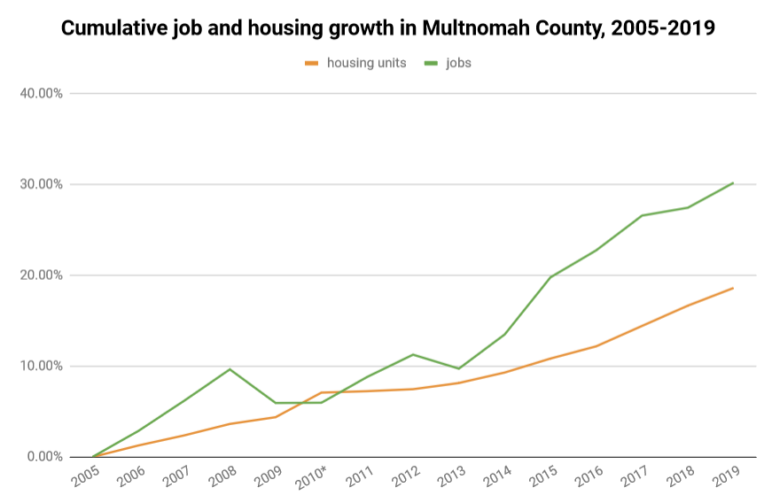
Source: U.S. Census American Community Survey. Data is here.
Next week, Portland’s city council is considering a proposal that could permanently lock into many other parts of Portland the system that let Penkin and his neighbors challenge the existence of the Fremont Tower.
Appeals don’t often kill a project – but the risk of appeals can
Most projects within Portland’s so-called “design overlay” are never appealed. Virtually all of those that do face rejections or appeals ultimately win, though winning an appeal isn’t always enough to save a project with a financing deadline.
To understand why the win/loss ratio isn’t the whole story, consider the case of Slabtown Square.
When the mixed-income, mixed-use apartment project on Northwest 21st Avenue was first proposed in 2015, the plan looked like this:
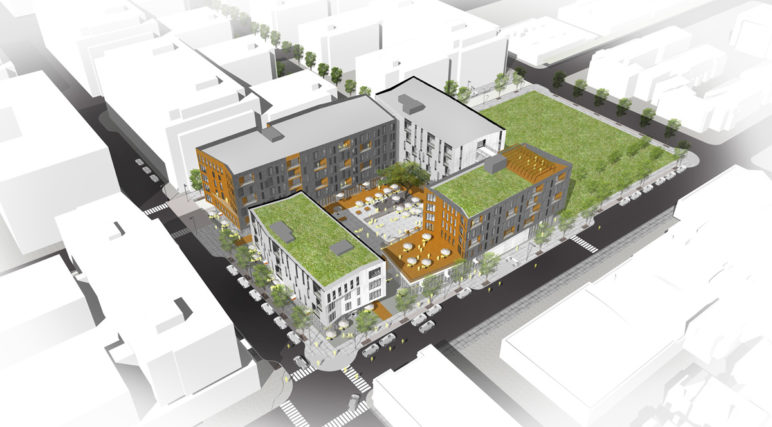
An early 2015 proposal for the design of Slabtown Square, by YBA Architects and PLACE Studio. (Via NextPortland.)
Neighborhood association representatives had pushed hard for a European-style central square, but didn’t like that the only way to fit it in while also building the homes that would fund its existence was for the project to encroach on the public walkway just east of the building. So the developer scrapped that plan and came back in 2017 with this proposal instead:
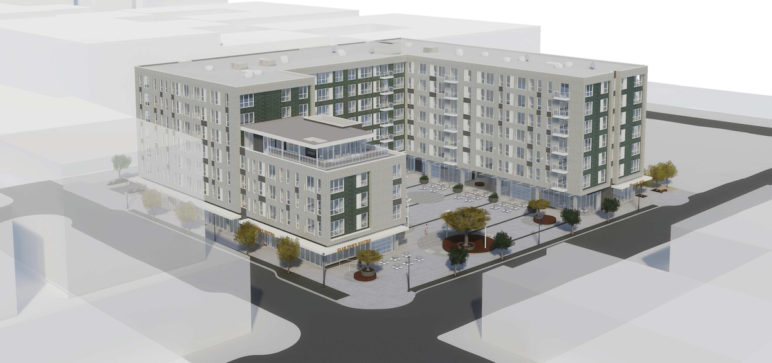
Slabtown Square’s final design, by LRS Architects and PLACE Studio. (Via NextPortland.)
The city’s design staff declared this version “substantially improved,” and the Design Commission signed off. But this approach didn’t please a determined group of nearby residents who felt the privately funded plaza associated with the building didn’t fit the bill the city had once promised. The Northwest District Association tied the project up in a string of unsuccessful appeals—first to Portland’s city council, then to the state’s Land Use Board of Appeals, then to the state court of appeals, and finally to the Oregon Supreme Court, which sealed the case in 2020 by declining to hear it.
Slabtown Square hasn’t opened yet. Neither has the publicly funded park that has, for four years now, been scheduled to open next door.
Would an investor with shallower pockets or a less well-connected architecture firm have stuck with the project? Would they have proposed it in the first place, knowing that such a string of appeals would be possible? It’s impossible to say.
One thing is certain. Despite all that hassle, the City of Portland is hoping that more people will be willing to keep proposing homes in Slabtown. The longtime industrial area is one of just a few neighborhoods outside Portland’s officially designated “central city” where it’s not illegal to build a seven-story apartment building.
If something about Slabtown Square’s six-year journey to construction gives an investor pause, and other homes in the area never get built, the effect will be the same as for any structures that go unbuilt. The hundreds of mostly well-off people who would have lived in them will instead find themselves in a big, cruel game of musical chairs, competing against every other Portlander for whatever homes are allowed to exist.
Housing projects are 20 times more likely than other projects to face design appeals
None of this is to argue that well-designed buildings are bad. They are good. Portland’s Design Commission consists of respected local professionals who are fully aware of the need for their work to improve projects without accidentally killing them.
When this system works well, it is a much smaller burden on new projects than, for example, the city’s long permitting timeline.
The risk, though, is that the system may be exploited, either in the form of obstructive appeals or threats by critics of the project who can credibly afford to appeal. Such threats create leverage, whether or not those critics ever follow through with a formal appeal.
But if we look specifically at the appeal rate, data released Friday by the Portland Bureau of Development Services shows that in the last eight years, design-regulated housing projects in Portland have received design appeals from the public at 20 times the rate of non-housing projects: 8 percent vs. 0.4 percent.
The issue here isn’t just that something like 1 in 12 housing projects can expect to face appeal from the public. It’s that Portland’s design appeal process is already being applied disproportionately to new housing.
If design appeal rights become permanent in homeowner-dominated areas, will they get more common?
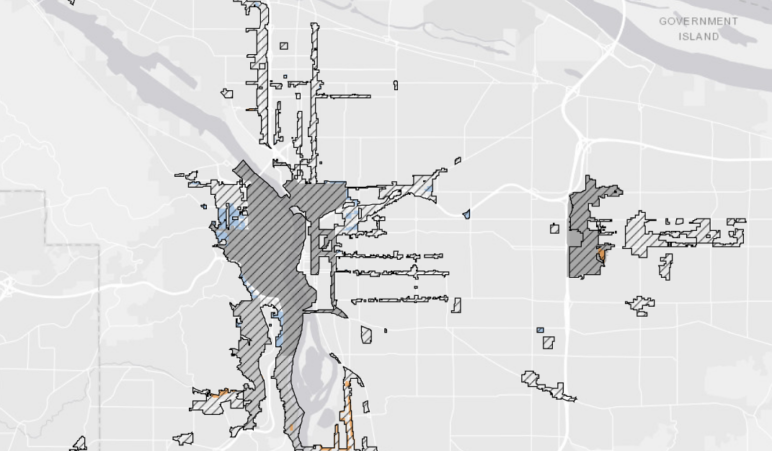
A map of Portland’s D overlay, where new building designs are regulated through subjective design review. The overlay (marked in hatched lines) was expanded beyond the shaded areas several years ago. Portland is about to decide when and where to apply a new point system of objective design standards instead of the subjective “design review” process.
Why do some projects draw more opposition, and more legal challenges, than others? The answer may have something to do with the raw number of nearby homeowners.
A national survey of 3,019 adults, published in 2017 by Harvard’s Joint Center for Housing Studies, found a clear trend. The closer a proposed apartment building is to the place a homeowner lives, the likelier they are to oppose its existence.
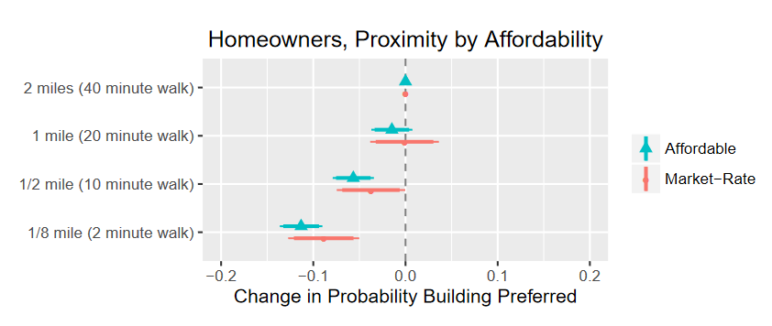
Source: Michael Hankinson, Harvard Joint Center for Housing Studies.
As the blue lines on the chart above show, this tends to be even more true of affordable housing than market-rate housing. But as the red lines show, it’s true of every project.
As with any polling trend, this doesn’t describe the opinion of every homeowner. And only a tiny share of homeowners will be willing to go so far as to legally challenge a project, or threaten to do so—especially if legal challenges aren’t a local norm.
But every homeowner near a new project presumably creates a small additional risk of appeal.
In most of Portland’s central city—where the appeal-vulnerable design review process has long been used—there are very few homeowners per acre. But it’s a different story outside downtown, where the city is proposing to start applying its design regulations.
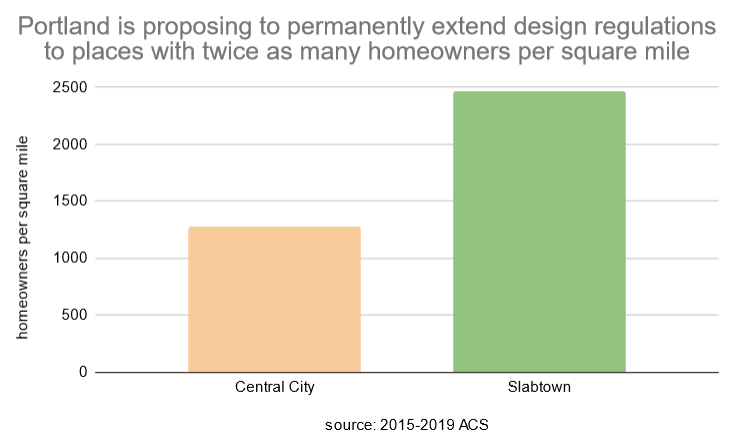
Homeowners per square mile in Portland’s central city and Slabtown.
In the two census tracts that include Slabtown and are mostly zoned for seven-story buildings, homeowners are twice as common as in the central city.
Supporters of permanently expanding the design review system into Slabtown and elsewhere, like David Keltner of Hacker Architects, don’t see this as a problem. They argue that because relatively few housing projects have been appealed in the past, and because those that do face appeals almost always win, the design review process must not be a meaningful barrier to new housing—and will not become one, even if it’s permanently expanded into neighborhoods with less urban atmosphere and many more homeowners.
“There has never been a case where a NIMBY neighborhood appealed a project to design review and had it shut down,” Keltner argued last month. “This proposal is not about affordable housing. It is an effort to remove a process a specific group of architects and developers are bad at.”
Other local architects disagree. They say it’s the threat of appeal and delay, not the final ruling itself, that creates unnecessary burdens on housing—and also on entry to their profession.
“Without an objective path to approval, our system rewards architects who are good at the process, not necessarily those who can deliver the greatest design,” wrote Sam Stuckey. “The architecture field is already one of great inequity and I am disappointed that so many of my colleagues are more interested in maintaining their relationship with the current system, rather than supporting new paths to participation in the design of our city.”
Objective standards could let Portland regulate mid-rise buildings in a new way
Early in this article, I said Portland’s city council will vote next week on a proposal to permanently expand its appeal-vulnerable design review process to more of the city—specifically to many of the onetime streetcar corridors that extend through seas of pricey detached homes. (Generally beloved commercial corridors whose buildings were, of course, constructed mostly in the early 1900s without any design regulations.)
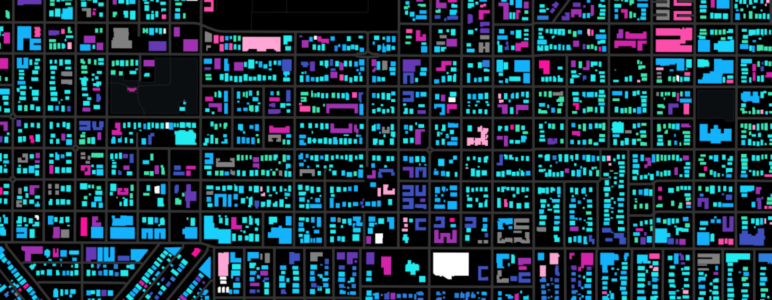
A visualization, by Justin Palmer, of the ages of buildings in inner Southeast Portland. Buildings in purple, pink and white were built after 1950.
Happily, Portland’s council has an opportunity to rethink its design regulation—a modern process developed with downtown skyscrapers in mind—for low-rise and mid-rise neighborhoods.
The city’s staff, Planning and Sustainability Commission, and Design Commission have spent five years working out a set of “design standards”—a LEED-style point system—that are designed to push developers toward interesting-looking buildings without also sending every project through the unpredictable, appeal-vulnerable Design Commission review.
The “design standards” option wouldn’t replace discretionary design review; any project could opt for the discretionary process if a builder wants to do something more creative. But having the new points system as a viable option would fulfill Oregon’s statewide mandate to offer a “clear and objective” path to taking advantage of a site’s zoning.
Last year, Portland’s planning commission unanimously voted to apply the standards to low-rise and mid-rise buildings—up to 75 feet in height, or about seven stories.
Taller structures, with their unique visibility, inherently deeper-pocketed investors and longer timelines, would still need to use the discretionary process.
Portland’s “point system” for regulating design has promise
Last month, Sightline joined a coalition of below-market housing developers, mixed-income housing developers, architecture firms, and advocacy organizations to urge the city to “ensure that this straightforward point system is an option for the vast majority of new projects outside the central city.”
Nick Sauvie, executive director of ROSE Community Development in outer southeast Portland, was one of many affordable housing providers working in Portland who signed the letter urging both market-rate and below-market housing to be able to use the objective point system in almost all situations. He warned that mandating the appeal-vulnerable discretionary process for buildings less than 75 feet “will lead to more projects killed, delayed, and made more expensive.”
If the point system for mid-rise buildings works, it might be usefully applied in other cities, too. Seattle has expanded its own discretionary, appeal-vulnerable design review system to many neighborhoods; a series of subsequent efforts to rethink the system have been unsuccessful.
“What you want is to eliminate your risk that you have around design review and the cost of it,” said Maria Barrientos, a Seattle-based apartment developer who said a single round of her city’s design review process generally adds about $250,000 to $300,000 to the total cost of a new building. “If there’s a list you can pick and choose and manage around, that’s a known thing.”
Objective standards can prevent bad design, but nothing can guarantee good design
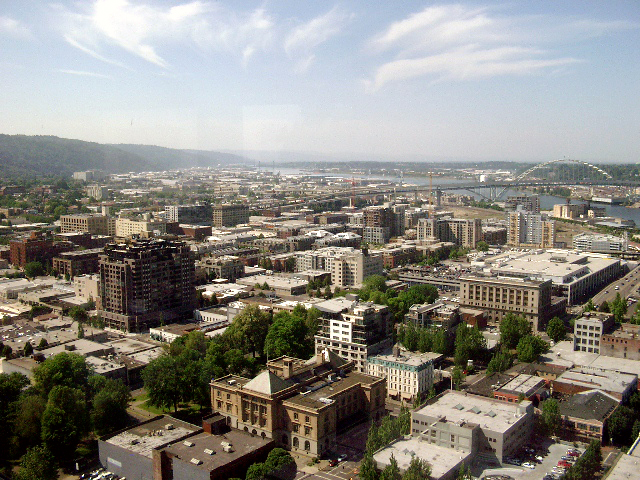
Portland’s Pearl District in 2006. Photo: Ajbenj (WikiMedia/Creative Commons).
Ben Schonberger, a senior planner with Portland-based Winterbrook Planning, said that in his observation, the uncertainty of the subjective Design Commission review process leads most builders to avoid it if they can.
“If you are savvy and skilled, you aren’t afraid of design review and can build that into your schedule,” said Schonberger, who also sits on the board of the housing affordability advocacy group Housing Land Advocates. “But we need all kinds of developers, not just those who are willing to go through the pain of design review.”
Objective design standards and subjective Design Commission review can both have a useful role, Schonberger said: “raising the floor” of urban design by ensuring that the very worst buildings don’t go in.
Objective standards alone, he said, can steer projects away from common problems: “Your building isn’t going to have blank walls, your building isn’t going to turn its back on the street, your building is going to have some articulation.”
But Schonberger said he doubted that either subjective Design Commission review or objective design standards will ever lead to more truly excellent buildings.
“What makes incredible buildings are passionate, interested, well-capitalized builders,” Schonberger said. “It’s just like any business—there are good ones and there are bad ones. If they’re not really interested in appearance, it’s going to be crappy no matter how many times you go through the design review process.”

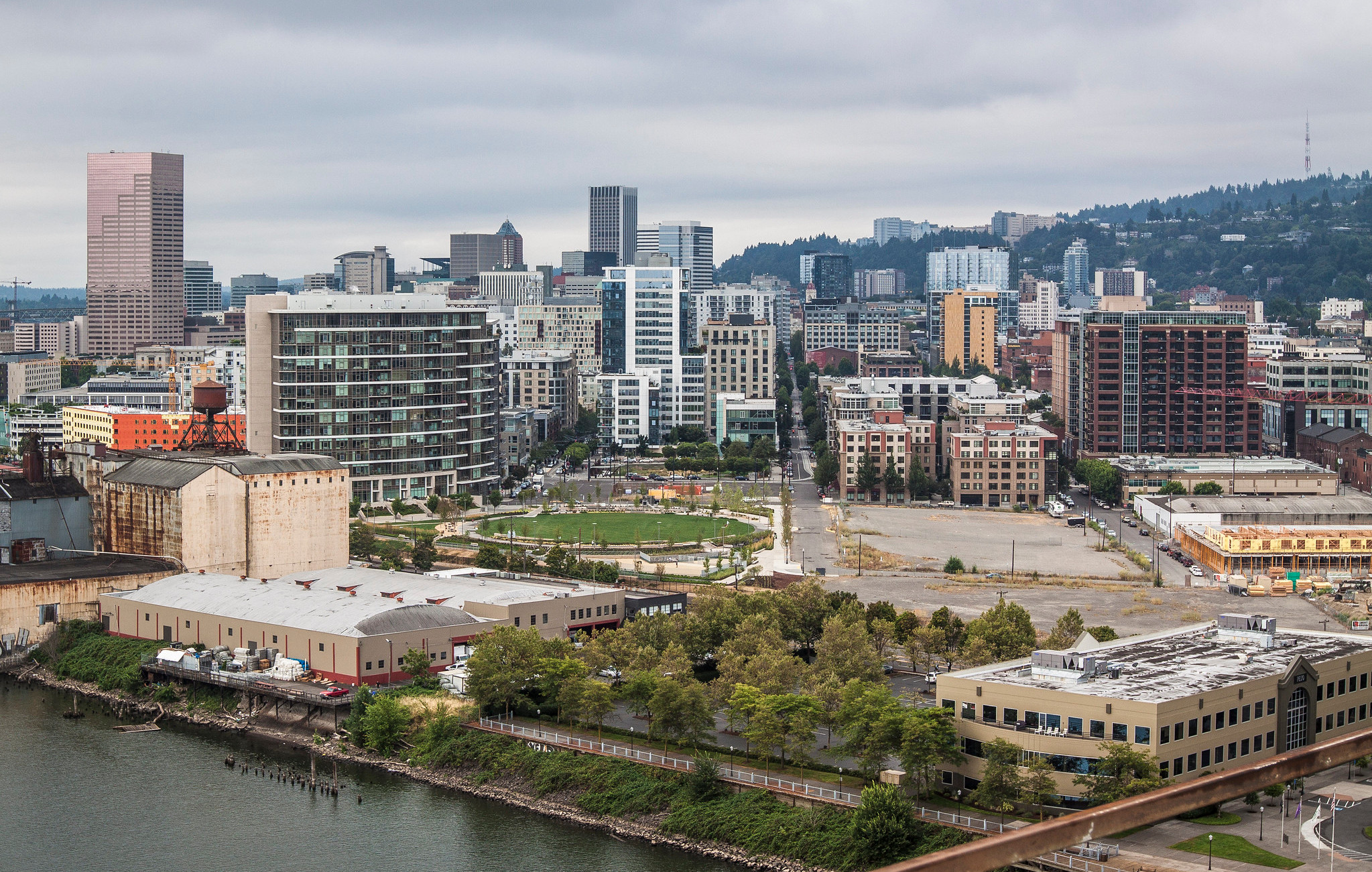
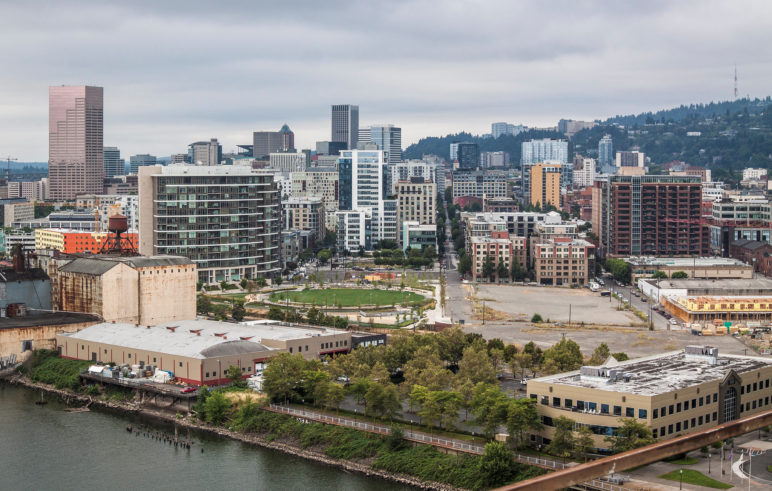







Dave Petersen
All of these solutions are simply Band-Aids for the larger problem of overpopulation. With population control there wouldn’t be a housing crisis, or a water crisis, or a looming food crisis. OK population drives every problem we have on earth.
At what point do we realize we’re over populated and voluntarily say enough? Well, it should’ve been maybe half a billion. Having utterly failed that cut off point, we might see reason take a little more emphatic hold at 9 or 10 billion. More? You can see 12 billion? 14 billion? – twice our present population?
Will our earthly problems become twice as hard to solve at 14 billion? Maybe it’ll be a difficulty on an exponential scale. Maybe things will get four times as hard, eight times as hard, 16 or 32 times as hard to deal with problems as we currently experience them. Do you think rent is a problem now? Try jamming twice or three times as many people in the same area and have them all compete for rent.
Nature will not allow us to go on insolently casting hungry babies everywhere. Nature is already pushing back with extreme water shortages, arable land shortages, fisheries shortages, depleting fertilizer stocks, resource shortages, and on and on and on. Are we that stupid as a species to not see the pushback from nature?
Can’t we, for just one or two generations, take hold of our responsibility and say birth-control is free – no limits on abortion – women’s education across the planet – no tax advantages for having children……
If we don’t see a loosening of the death grip that nature now has on humanity, if we can’t see improvement in our quality of life, If we don’t see the shortages in water and land and food and elsewhere begin to recede, then we can just revert back to a present way of life and wait for the end – for it won’t be long.
Continuing along with our Madison Avenue driven lifestyles, in our capitalism driven “Consume Everything” lifestyle, we’re in big big trouble.
Roberta Sproul
I agree with your sentiment 100%. I see no point at all in attempting to reduce usage of natural resources so long as unrestricted births are encouraged and celebrated. Our leaders would do well to spend more time and dollars on natural birth control education, and sex education. We do not need to continue to breed like rabbits.
Molly Jay
A thousand times yes. My husband and I chose not to have children, and we resent seeing our quality of life repeatedly stomped on by legislatures striving to accommodate the mindless breeding decisions of others. A decision not to procreate has a significantly more positive impact on environmental issues than any attempt at recycling, etc.
ballardite
Wow ugly block housing with no greenery or large trees. Total heat sink. Not what I want for Seattle. Why do people from other cities come here and tell us that we should settle for rowhouses on denuded land like Chicago has. Or skyscraper condos like New York City.
#1 There are 72,000 vacant apartments in greater Seattle Area RIGHT NOW!
#2 The 27 Urban Villages have all been upzoned and not a one is built out yet. There is plenty of housing in various stages of building in all of them – we’re talking 10s of thousands of units and its a mix of missing middle housing plus apartments and condos. Enough for all the housing need predictions for the next 5 years from what I have read.
We should take our time making good plans for how best to upzone next. This means get architecture teams to each of the 27 neighborhoods to make individual upzone plans for each that save the neighborhood landmarks and character. Include necessary infrastructure upgrades in the plans and then let the neighborhoods comment and truly listen to their input.
Most of all – don’t let developers have a free for all – they only think about getting the most for themselves. Government needs to control them for the good of all.
Michael Andersen
If there were zero vacant apartments in the Seattle area right now, how much faster would landlords be able to raise rents without starting to worry that they might end up with one or more of those vacancies in their building?
El Monstro
Baldwin County in Alabama has 33,131 empty homes RIGHT NOW. That is 28% of their housing stock! Why don’t people just move there? You can literally have them for $1.
Michael Andersen
Good idea! We’ll be right behind you.
Jeremy
Any protections for solar PV panels when a neighbor’s house is up-sized? gardens?
Michael Andersen
For better or worse, the maximum building height is 30′ from the lowest point on the lot, or 35′ in the case of the sixplexes and 20′ in the case of ADUs. Combine that with a five-foot setback and every rooftop panel and tomato box is gonna be in pretty good shape.
Lou Berkley
An interesting article! A couple of questions come to mind;
1. Why don’t any of the AMI figures work out to a more or less consistent dollar (income) amount, regardless of the building option?
2. The rationale for better utilization of property space and increasing affordable housing is premised on the benefits of rental ownership.
But when literally EVERY politician in the US supports rental moratoriums which begin with the assumption that EVERY Landlord is a paycheck-wringing Slumlord and EVERY Tenant needs to defer their rent even if their paychecks are unaffected by Covid, then the benefits of rental ownership evaporate into thin air, and flipping the property becomes the only attractive option.
This hits small time & retired owners especially hard, and (perhaps not coincidentally) fuels the current feeding frenzy by corporations and financial institutions now buying up single family homes.
The rental moratorium is either P.R. legislation meant only to make politicians look like they care about ‘the little guy’, or it’s intentionally pushing ever more single family homes out of reach by individuals and into the clutches of big business.
So for those who are considering even just an ADU, where’s the motivation???
Michael Andersen
Good questions.
1. The implied AMI figure is different for different units because the units would be expected to have different bedroom counts and are therefore built to accommodate households with different sizes and incomes. (Basically: a project shouldn’t be able to fulfill an affordability requirement ENTIRELY by being small … you also have to be cheap.)
2. Despite some bold headlines, I haven’t seen evidence that corporate landlords are approaching a significant share of single-detached housing market. But to the extent that their share is growing they wouldn’t be buying up single-detached homes for rental unless they thought (rightly or wrongly) that they’re a good investment.
That said, I do think it’s worth worrying about well-intentioned tenant protections driving small landlords out of the business or, probably even worse, convincing homeowners in exclusive areas to dump their rising home equity into an index fund or something instead of creating additional housing with an ADU or the like. One possible way to mitigate for this risk is to make it easy to split a lot and sell it off with a new home atop it – that way you don’t have to be a landlord if you don’t want to be, you just have to be a neighbor. A few months ago, Oregon passed a law allowing the owners of newly built plexes to drop lot lines down the walls, even without any street frontage on the newly created lots. I would love for this to happen in other states, and to become an option for ADUs as well. A downside of this is that it would restrict the number of homes available to renters … but if we assume there are always a large number of renters on the margin between buying and owning, any new surplus of homes for sale is likely to soak up those tenants and then they’ll no longer be competing for homes in the for-rent market. That’s one reason I don’t worry *too* much myself about the unintended supply effects of most renter protection measures.
Lou Berkley
Hiya Michael,
1. Not sure how the %AMI could be a useful yardstick when the ‘goalposts’ are a moving target, based on the presumed subset of home buyers changes based on what sort of home they’re expected to purchase, but OK.
2. As to the impact of financial institutions on the single family home market, a quick lookup on “Blackstone buys single family” will easily net a dozen stories, and that’s just one recent example. The whole game is being grabbed by the big dogs.
3. Finally, the idea of making lot-splitting easier nationally is a heavy lift; it not only invites the inevitable NIMBY pushback, but it also does nothing to fix the inherent flaws in the current rental moratorium laws, such as the long-delayed benefits checks, non-existent means testing, and it’s inherent adversarial premise.
Before you dismiss the unintended effects of the ill-considered and poorly executed moratorium, you might talk with a few small time landlords, especially those who are retired. It’s clear that the dynamics at work are rapidly thinning out your imagined pool of tenants who are on the threshold of buying, eliminating the income benefits to landlords, and instead are pushing the entire rental industry towards monopoly.
Michael Andersen
On 1, I think the absolute price and the relative affordability based on bedroom count are both important in different ways. That’s why we included both.
On 2, I’m aware of the recent boomlet in coverage of BlackRock (and maybe Blackstone too?) but I thought this was a fairly persuasive debunking of the suggestion that there’s an actual major trend afoot here. https://www.vox.com/22524829/wall-street-housing-market-blackrock-bubble Large institutional investors are a single-digit share of the detached housing market. That’s not the whole game.
Lou Berkley
You should get out more; this transfer has been underway for years, and while you minimize it’s impact, the SFH market availability is suffering from the Death of a Thousand cuts.
I’m not arguing against ADU’s, upzoning, etc., but rather for looking at the whole board, and fashioning solutions that are effective, wholistic and balanced.
“The Great Housing Reset has led to growing numbers of single-family homes shifting from owner-occupied housing to investment vehicles for large corporations.”
https://www.bloomberg.com/news/articles/2019-10-04/the-decline-in-owner-occupied-single-family-homes
“Welcome to the neighborhood: Blackstone, Starwood merger to create nation’s biggest single-family landlord.”
https://therealdeal.com/2017/08/10/welcome-to-the-neighborhood-blackstone-starwood-merger-to-create-nations-biggest-single-family-landlord/
“Blackstone is once again going all-in on the single family rental market.”
https://therealdeal.com/2021/06/22/blackstone-to-acquire-single-family-rental-firm-for-6b/
“We’re seeing the market flooded with institutional capital,” Mynd CEO and co-founder Doug Brien told the publication.”
https://therealdeal.com/2021/06/02/invesco-backed-mynd-to-spend-5b-on-single-family-rentals/
Nathan
This great, thanks Michael! Do you guys have an idea of what these varying unit types would go for if they were for ownership instead of rent? I believe the state just passed a law allowing for the subdivision of exactly these types of projects.
I saw your PDF has total costs for each scenario, but I’m not sure if they’d vary in a “for sale” model or if there’s a particular profit margin you’d expect.
Any chance you’ll do a round up of the various state measures passed this year and impacts on housing?
Michael Andersen
Great question. We used rent figures for this exercise because we wanted apples-to-apples comparisons with the group home and home-on-wheels scenarios, but over the long run I’d expect ownership products to be slightly more likely to happen across the board, in part because of the various ways the United States subsidizes homeownership. That said, if you’re building stacked flats (like the two-up-two-down fourplex in our illustration) your only ownership option is a small condo association, which can create some overhead cost and make it harder to find buyers.
If you want to use the data in our PDF to estimate the for-sale costs, the “total costs” line (construction+land+fees) is a good place to start. However, you’d need to add the ROI, marketing and sales costs to that figure.
You are totally correct about this year’s SB 458 allowing middle housing lot splits. I have been failing for weeks to publish a roundup of this year’s legislative session. Now that this project is published, it’s near the top of my list.
Nathan Wildfire
Michael – thanks for the great article and analysis. As a fellow Portland resident, I’m curious what figures ($ amounts) you might use if you were to assume an average standard vacant lot in Portland. I know the cost of a vacant lot varies wildly across various Portland neighborhoods – but as a thought exercise, I’m curious what a significantly lower acquisition costs and zero demolition costs would do to the analysis. Another way of asking the question – how economical would each of these scenarios be for standard vacant lots in Portland? Some neighborhoods have very few – but others have tens and sometimes approaching 100. Thanks for considering the question.
Michael Andersen
Good question! In that situation, I think the biggest question is: what is it that’s prevented those lots from developing already? Presumably the owners of those lots (to the extent that they’re not stuck in escrow etc) have been actively deciding not to sell for $X. The classic way to convince someone to sell something is to offer them more money than they were previously getting offered.
So, will this reform increase the amount of money that someone can get by selling their vacant lot, compared to the old code where you could build a colossal oneplex on any lot? Maybe a bit, but probably not much. The smaller building size probably reduces the value of the land by as much or more than the higher unit-count allowance would increase it. And if rents in a given neighborhood are not high enough to cover the ~$200 sqft construction cost as well as the land and other fixed costs of a project, then nothing will be built until that changes.
THAT SAID, if and when those vacant lots do someday develop, these figures suggest that the most revenue-producing thing to build would probably be a triplex or fourplex. As to what price they’ll come in at once built … that’s not driven by the project costs, unfortunately. It’s driven by the market rents in the neighborhood. The project costs just determine whether the project will happen at all, given certain prices for land and for living space.